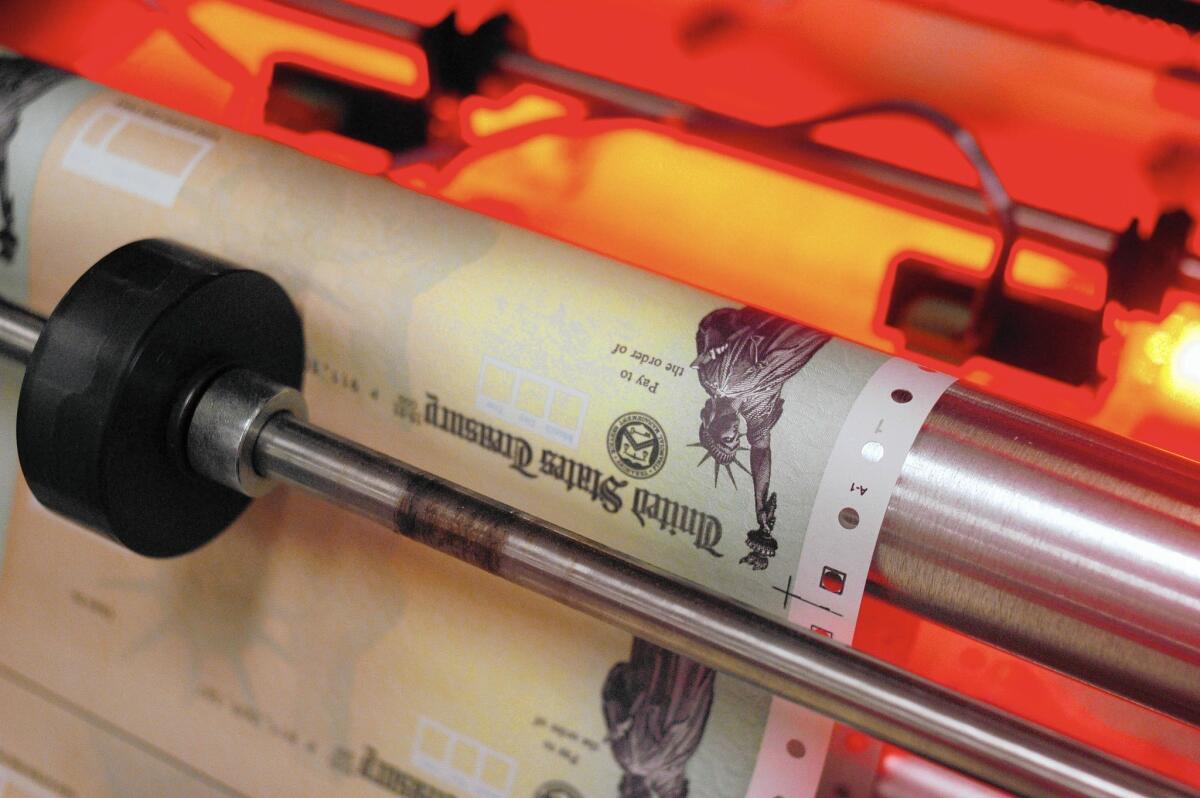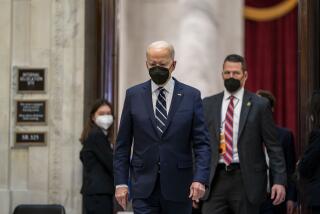Checks to Americans will ease the coronavirus slump, but they may not be much of an economic stimulus

- Share via
WASHINGTON — President Trump’s proposal to send checks to virtually every American adult would probably be a godsend to millions of lower-income households threatened by nationwide shutdowns and social distancing in response to the coronavirus.
The lump-sum payments, the exact size of which has yet to be determined, are a key element in the administration’s latest effort to offset the cascading economic damage triggered by the pandemic.
Treasury Secretary Steven T. Mnuchin has reportedly asked Congress to approve a $1-trillion package that includes $500 billion for direct payments to Americans in two rounds, in early April and a second in May. He has indicated that high-income individuals would not qualify.
On Wednesday, Trump said those figures are under consideration, but added: “We are looking at different numbers.”
An initial payment of $250 billion would translate to about $1,000 per person if every American over 18 got a payment.
“It’s certainly a beginning. It’s necessary. It’s vitally important to put money into pockets of people who are likely to spend it,” said Robert Reich, the former Labor secretary in the Clinton administration and a public policy professor at UC Berkeley. “The more people who have this kind of economic security, the better off all of us would be.”
But it remains to be seen if the proposed payments provide much immediate stimulus to an economy paralyzed by the health crisis.
The latest updates from our reporters in California and around the world
The federal government has sent checks to Americans before. In 2008, individual taxpayers received up to $600, and married couples up to $1,200, in a $168-billion tax-rebate program by the Bush administration to battle the economic downturn.
Research has shown that such direct payments are spent quickly, especially by households with little savings and wealth, and thus can be effective in giving a short-term lift to the broader economy. This time there’s likely to be less bang for the buck.
That’s because large portions of the American economy have been shut down, so they’re effectively cut off from greater consumer spending power.
Also, following the advice of public health experts, many Americans are practicing social distancing: They are not going out to mingle in bars and restaurants and shopping malls.
And middle-class and upper-income people would be even more prone to sock away the money.
“You’re not going to make people travel more. You’re not going to make them go to restaurants and things like that. Maybe on the margins, people will do more takeout and do more groceries,” said Marc Goldwein, senior policy director for the nonpartisan Committee for a Responsible Federal Budget.
Harvard economist N. Gregory Mankiw, who served as an advisor to President George W. Bush, endorsed the idea of a $1,000 check to every American. But he said the cash disbursement should be seen as “social insurance” rather than stimulus aimed at boosting demand.
Although wages for lower-income workers have been growing faster in the last couple of years as unemployment has fallen, many of them — and middle-class households also — live paycheck to paycheck.
A Federal Reserve report last year said that 4 out of 10 Americans would have trouble covering a $400 emergency expense.
Trump had been pushing hard for a payroll tax holiday instead of direct payments, but after a cool reception from lawmakers from both parties, he acknowledged Tuesday that that may not be the best way.
A payroll tax holiday would only help people with jobs, and those who earn more would get a bigger benefit. What’s more, it wouldn’t be a lump sum, but a savings that workers would see with each paycheck.
“It does come over a period of months, many months, and we want to do something faster than that,” Trump said at a White House news briefing Tuesday with the coronavirus task force. “We’re going to do something that gets money to them as quickly as possible.”
Mnuchin, standing at Trump’s side, declined to say whether income restrictions would be applied to the cash payment program. But he said: “I think it’s clear we don’t need to send people who make a million dollars checks.”
The cash distribution plan is part of an overall $1-trillion package that also includes help for small businesses and hard-hit airlines.
Separately, the administration is providing a three-month deferral on income tax payments that would have been due April 15, making an estimated $300 billion of cash available to households and businesses through mid-July.
The idea of sending checks to every American had the backing of some prominent economists, liberal and conservative, and lawmakers, including Sen. Mitt Romney (R-Utah).
“It does seem that these can be effective,” said Randall Kroszner, a former Federal Reserve governor who is a professor at the University of Chicago Booth School of Business.
But, he said, “if such a program is done, it has to get the money out super quickly. That is the key thing for people who are strained and have few assets.”
Many people are already seeing their incomes cut as their work hours are slashed or they are told simply to stay home. Workers most at risk include millions in the leisure and hospitality industries, transportation services and the energy sector.
Marriott, the world’s largest hotel company, said it is expecting to furlough tens of thousands of employees as it temporarily closes hotels around the world.
The waves of business closures, especially in the food, entertainment and travel industries, will not necessarily provide continuation of wages for those employed in the affected sectors of the economy.
Paid sick leave is by no means universal in the United States, though a form of such assistance is included in the coronavirus relief bill approved by the House and supported by Trump.
“Because so many Americans have little or no emergency savings, cash payments can help keep food on the table and bill collectors at bay for those workers in the service industry,” said Jack Gillis, executive director at the Consumer Federation of America.
Reich, the Berkeley economist, said he was worried whether the cash payments would be enough “for people who are laid off, have to meet rent payments, buy food and keep their family afloat.”
He recommended $1,000 for every adult and $500 for every child, and to keep it going monthly depending on the severity and duration of the health crisis.
In addition to helping those who are most vulnerable financially, such payments would probably still help bring a quicker recovery from what many economists now consider the near certainty of a recession.
Trump and lawmakers are mulling sending checks to U.S. households to help mitigate the coming downturn. It’s a big part of the answer, but just a part.
Although Mnuchin said the plan was to send checks in two weeks, it’s unclear whether government could move that quickly. Mnuchin said he would be discussing details with Congress on how the program would work.
One way it could be done is to send checks to everyone with a Social Security number and then have those who exceed income thresholds essentially pay that back when they’re filing taxes next year, Goldwein said.
He said it would provide some stimulus in that it “would help people that would have their spending go down close to zero.”
But the overriding goal, he said, is for it to help stabilize the economy.
“Recovery could take a long time if after everything goes back to normal health-wise, nobody has money. And so, this can help make the recovery a lot faster,” Goldwein said.
“We know we’re in for a period of severe economic pain, and some of that is by design because that’s the only way to solve this public health issue. But we want to know that when we get through this issue, we can come out the other end.”
More to Read
Get the L.A. Times Politics newsletter
Deeply reported insights into legislation, politics and policy from Sacramento, Washington and beyond. In your inbox twice per week.
You may occasionally receive promotional content from the Los Angeles Times.












